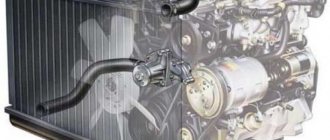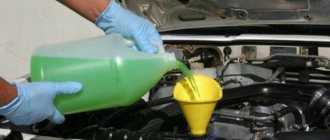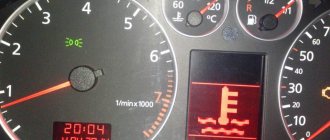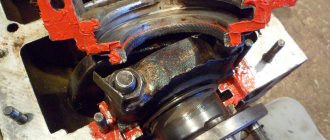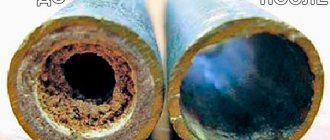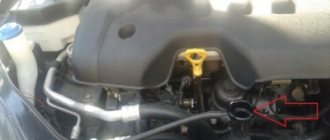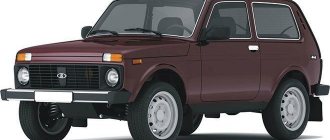Working fluids in a car must be replaced in a timely manner. During operation, contaminants, deposits and metal shavings accumulate in liquids. Also, the liquids themselves tend to lose their protective and other beneficial properties over time. Engine cooling system fluid (antifreeze, antifreeze) is no exception. The main task of this working fluid is to maintain the specified operating temperature of the engine by removing heat as a result of continuous circulation through the cooling system. Also, the coolant (coolant) provides heating to the heater to warm up the interior space of the car.
We also recommend reading the article on how to flush the engine before changing engine oil using a diesel engine as an example. From this article you will learn about when and with what means you need to flush the engine.
An additional function of the coolant is to lubricate and protect parts from corrosion. The fluid contains a package of special additives to lubricate the pump (water pump) and prevent the formation of rust in the cooling jacket of the engine cylinder block. It is recommended to change antifreeze once every 3 years.
Why do you need to drain the coolant?
The cooling system of modern cars uses antifreeze as a heat transfer fluid. At first glance, it may seem that this fluid does not need to be replaced, because the system is closed and nothing gets into it from the outside. The main components of antifreeze are ethylene glycol and water, but no less important are additives that prevent corrosion of cooling system elements, lubricate and protect them. As the vehicle is used, the additives lose their properties, which leads to the formation of corrosion with subsequent disruption of the performance of parts. As a result, particles of metal and other materials settle and clog the radiator and other system components. This leads to deterioration in engine cooling and, as a result, to overheating.
When to change antifreeze
Antifreeze must be replaced in several cases:
- Loss of coolant characteristics. This happens due to constant temperature changes, evaporation, and oxidation.
- Adding water or other liquid to antifreeze in emergency cases. There are situations when, due to boiling antifreeze or other reasons, additional liquid is required, but there is simply none at hand. Therefore, ordinary water or antifreeze of a different class or brand is often used. After such manipulations, the antifreeze needs to be completely replaced.
Antifreeze resource
Antifreeze, like any other technical liquid, has a certain service life, which is indicated by the manufacturer or automaker. Basically, antifreeze is changed every 2-3 years. If we talk about modern cars, the coolant is changed when it has been in use for more than 5 years or a mileage of 250 thousand km, which is typical for Volkswagen cars. AvtoVAZ stipulates replacement after 75 thousand km. or 3 years of antifreeze operation.
Signs of coolant replacement
The following signs indicate the need to replace antifreeze:
- the liquid loses its original color and becomes brownish. This indicates corrosion of system parts. Such antifreeze needs immediate replacement, regardless of its service life;
Summary
I hope this article describes the process of replacing the coolant solution in sufficient detail. But, however, many operations are carried out from below the car, and they need to be carried out either in a pit or on a lift.
So, if you don’t have a pit or a lift on your farm, then replacing it will be quite labor-intensive. You will need to jack up your car and be prepared to do a lot of the work while lying on your back under the car.
If you are not ready to endure these inconveniences, then in this case it is better for you to use the services of a service station. The operation of replacing the coolant solution itself is one of the cheapest in the service station price list.
Repairing a car with your own hands is often the only way to restore the functionality of the vehicle. For some car owners, this process has become simply interesting, because they need to obtain high-quality information to carry out repair work. The main source of correct information about the design of your car and the process of performing certain tasks is the operating instructions for a specific car model. It is important to understand that one incorrectly performed action will cause a lot of trouble.
When it comes to the cooling system, there is a need for careful work, because the system is quite delicate. If the liquid is drained incorrectly, a certain amount of old antifreeze will remain in the pipes and reservoirs, and the machine will not be able to operate normally. You will have to constantly look for problems and try to understand their nature. Therefore, changing the coolant must occur according to certain rules.
How to prepare a car for draining coolant
To drain the antifreeze, you need to perform some preparatory measures. Since the substance in question is toxic, it should not be dumped on the ground. For these purposes, resealable containers are used, which are disposed of in accordance with environmental standards. Preparing the car consists of placing it on a flat horizontal surface to more effectively drain fluid from all pipes and components. On almost all cars, the coolant is drained through a special hole, which is sometimes located in the lower part of the radiator or on the pipes.
If there is no hole, drainage is carried out through the removed radiator pipe.
An important point is compliance with safety precautions: draining antifreeze from a hot engine is strictly prohibited. Due to the high heating temperature of antifreeze, there is a high probability of getting burns during operation. In addition, as a result of heating, the liquid in the system is under pressure and when any lid is opened, it will be released. Therefore, you first need to wait until the engine cools down to ambient temperature and only then unscrew the cap of the expansion tank and radiator.
How to drain antifreeze
Draining coolant from the system can be divided into several stages, each of which has its own characteristics.
Through the radiator
After preparing everything you need, follow these steps:
- Remove the motor protection by unscrewing the corresponding fasteners.
Video: draining antifreeze from the radiator
From the engine block
Since draining antifreeze from the engine block is a continuation of the procedure under consideration, we move the container under the drain hole on the engine and perform the following actions:
- We remove the elements that prevent free access to the drain plug. Depending on the car brand, these elements may vary.
- Carefully unscrew the plug.
From the expansion tank
Over time, sediment collects in the expansion tank. Therefore, when replacing the coolant, draining the substance from this container and rinsing it will not be superfluous. The essence of the procedure is to disconnect the pipe going to the radiator, followed by draining the liquid into a suitable container.
Another option is possible: the coolant can be drained through the neck using a thin tube, for example, a medical dropper.
Video: how to drain antifreeze from the expansion tank
Using jacks
The actions when using jacks largely repeat the standard procedure for draining antifreeze. After installing the container and unscrewing the plugs, the rear wheels are raised as high as possible. After 20 minutes, the car is lowered and only the left wheel is raised. After the same period of time, the car is lowered and the right wheel is raised. After such actions, a certain amount of liquid will pour out of the system each time.
A similar procedure can be used for repairs in the field by placing the machine on an incline.
Using a compressor
An air compressor can also be used when draining antifreeze. It is connected to the cooling system and air is supplied, gradually removing coolant. Although this option can be considered, but only as a last resort, since depending on the power of the device, too high a pressure may be created in the system, which will damage the plastic elements. In addition, not every car enthusiast will have a compressor of the required performance at hand.
Video: draining antifreeze using a compressor
Antifreeze must be replaced after a certain period of operation or mileage, as well as according to characteristic signs. It is not recommended to drive with a coolant that has lost its properties, since the wear of the elements and components of the cooling system increases. After familiarizing yourself with the step-by-step procedure, almost every car enthusiast can drain the antifreeze.
Source
Draining antifreeze or antifreeze from the cooling system and engine block
Working fluids in a car must be replaced in a timely manner. During operation, contaminants, deposits and metal shavings accumulate in liquids. Also, the liquids themselves tend to lose their protective and other beneficial properties over time. Engine cooling system fluid (antifreeze, antifreeze) is no exception. The main task of this working fluid is to maintain the specified operating temperature of the engine by removing heat as a result of continuous circulation through the cooling system. Also, the coolant (coolant) provides heating to the heater to warm up the interior space of the car.
An additional function of the coolant is to lubricate and protect parts from corrosion. The fluid contains a package of special additives to lubricate the pump (water pump) and prevent the formation of rust in the cooling jacket of the engine cylinder block. It is recommended to change antifreeze once every 3 years.
Drain plug with neodymium magnet
Of course, the oil filter protects the lubricating fluid from contamination by debris and metal shavings. However, the cleaning element does not work flawlessly, and still some amount of debris ends up in the engine oil. This leads to wear and tear of the main components and assemblies of the car engine. Well, engine wear casts doubt on the ability to drive such a car.
To solve this problem, magnetic drain plugs were designed. A neodymium magnet is installed on the tip of such an element - small in size, but quite powerful. It attracts metal shavings from the oil (the properties of the substance allow this to be done even with boiling oil). As a result, the performance of the engine and the vehicle as a whole improves.
Of course, a magnetic plug costs much more than an ordinary one, but still the price of a part with a neodymium tip cannot be compared with the cost of a major overhaul of a car’s power unit.
Removing spent coolant from the system
Replacing the coolant involves draining the used material. Remember that antifreeze is a harmful chemical with a sweet smell. The coolant is drained into closed containers and then disposed of!
Before starting work, the vehicle must be placed on a flat horizontal surface. In this position, the liquid will drain faster, and the amount of residue in the cooling system and pipelines will also be minimized. Structurally, the cooling system often has a special drain plug to remove spent liquid. This antifreeze drain plug is located at the lowest points of the cooling system circuit (near the lower corners of the cooling system radiator).
- Please note that draining coolant from the system on a hot engine is strictly prohibited. The fact is that as the liquid heats up, the pressure in the cooling system increases in parallel. Thanks to this pressure, the liquid does not boil. If you unscrew the drain plug or remove the hose from the radiator, then the pressure will drop to atmospheric pressure, and hot liquid will escape in the form of steam.
- At the very beginning, you need to let the engine cool, after which you will need to unscrew the cap of the expansion tank of the cooling system. Next, prepare a container for draining. After this, the drain plug is unscrewed or the pipe is removed from the radiator, and used antifreeze or antifreeze begins to flow into a previously prepared container. This removes the bulk of the liquid from the system.
Let us add that if you change the coolant according to the regulations, regularly flush the system with distilled water before adding new fluid, and do not worry about the compatibility of the remains of the old fluid and the new one, then this method will be sufficient.
At the same time, remnants of the coolant remain with this draining method, since there are areas in the cooling system that are located below the installation location of the drain plug (interior heater radiator, etc.). To completely remove the working coolant from the engine cooling system and the channels in the cylinder block (cooling jacket), additional manipulations will be required.
Possible consequences
As a rule, special fluids are used to service cars: antifreeze, antifreeze. Regular use of a vehicle leads to a deterioration in the quality of such compounds. This is what often leads to the appearance of foam in the system. And this, in turn, causes corrosion not only in the cylinder block, but also in the radiator and thermostat.
But that's not the worst thing. The appearance of foam can be the main cause of cylinder block failure. In this case, serious repairs are required. Not every car owner knows how to drain coolant from the system. Therefore, it is worth considering this issue in more detail.
Complete drain of antifreeze
To answer the question of how to completely drain antifreeze from the engine block, it is necessary to take into account the design features of the cooling system. This hydraulic system has separate sections from which it is impossible to drain the liquid by gravity. The coolant partially remains in the cooling channels in the cylinder block, which are located at a certain angle.
- To implement the task, you need to wait until the liquid has completely drained from the drain hole, after which there is no need to screw in the drain plug. You only need to tighten the cap on the expansion tank. After this, the heater in the car is turned on to maximum and the engine is started.
- Start the engine for just a couple of minutes and carefully monitor the process, since the risk of overheating the internal combustion engine without coolant in the system is very high. Overheating can cause the engine block to warp, seize the engine, or have other devastating consequences. Even if liquid continues to flow out of the drain hole while the engine is running, the engine still needs to be turned off without waiting for complete drainage. After this, the engine needs to be allowed to cool for about 20 minutes, and then the engine starts again, but for no more than a couple of minutes.
- Stopping the flow of antifreeze will indicate that the remaining liquid has drained from the cylinder block. Now the drain plug can be tightened (if the radiator pipes were removed, then they are returned to their place and checked for secure fastening).
Correct algorithm
When a car owner asks about replacing antifreeze, he has to obtain information about how to properly replace the coolant, and in what sequence all actions must be performed.
Usually they start by emptying the cooling radiator located in the front of the engine compartment. It has a similar hole at the bottom, which is closed with a hexagonal head. Armed with a wrench of the appropriate size, you need to unscrew the head outward. If unscrewing turns out to be too labor-intensive, it is better to use the so-called “liquid key”. This will not only make your task easier, but also prevent damage to the radiator housing, which may result in the need to replace it.
Next in line is the engine. Where the plug is located was discussed a little higher. Having found it on the side of the cylinder block, you need to unscrew the bolt and remove the gasket placed under it. In other words, the algorithm of actions turns out to be absolutely similar to that used when working with a radiator. The thread may turn sour over time, so it is best to generously treat the surface with liquid key and only start working after a few minutes.
Filling with fresh coolant
The final step is to fill in fresh coolant in accordance with all recommendations and in compliance with the proportions in the case of self-diluted concentrate.
- Pour new coolant into the expansion tank, filling it to about.
- Next, it is recommended to tighten the cap on the tank, and the engine itself can be started. Be sure to pay attention to the fact that the stove in the cabin must be turned on.
- As a result of the first start of the engine, the pump will begin to work, the liquid will be evenly distributed throughout the system, and the level in the tank will noticeably decrease. This is due to the fact that when the car is turned off, when filling antifreeze, all pipelines and the total volume of the cooling system cannot be completely and immediately filled.
- When the level in the tank drops to a minimum, the engine is turned off. Then you will need to add coolant again to the maximum level by unscrewing the tank cap again. After topping up, screw the cap on and start the engine again. This procedure must be repeated until the fluid level in the expansion tank stops decreasing after a test run of the engine.
- It is also separately recommended to carry out a final check of the coolant level after replacement after 1-2 days of using the car.
Source
The nuances of removing the plug in the engine
After draining the fluid from the radiator, you need to pay attention to the engine. It is better to place a container under the motor, and then find a drain plug. In most cases, it is located on the motor block. It is located at the front of the cylinder block, below the ignition coil. If necessary, you can remove the ignition module. In some cases it gets in the way a little, but there shouldn’t be any difficulties with dismantling.
After the fluid has been drained, let the engine sit for 10 minutes. This is an indispensable condition when you need to drain the cooled liquid. It is important to ensure the safety of all mechanisms so as not to lose parts. The drain holes can be wiped with a clean cloth, and the seals can be replaced.
How to drain antifreeze completely: from the engine block, radiator
Any vehicle requires proper care. Therefore, every owner must carry out timely maintenance, change spare parts and make repairs. Equally important is the timely replenishment of consumables and their replacement (antifreeze, tires, gasoline, wipers, brake fluid). Particular attention should be paid to antifreeze (an alternative name for antifreeze).
This liquid requires special attention and requires periodic replacement, as it is not able to constantly retain its original properties. Antifreeze or antifreeze, if of proper quality, should maintain the optimal temperature range for the engine. To prevent the engine from running out of wear and tear, a temperature of 90 degrees is needed. Gradually, the antifreeze undergoes structural changes, due to which the liquid is no longer able to control the temperature and the engine begins to heat up. To ensure that the car does not boil in the future, and other components remain operational, every driver must know how to completely drain the coolant.
When is it time to change antifreeze
Each manufacturer encloses a special book with its car with detailed technical characteristics, as well as care rules. There should also be information about when the antifreeze needs to be replaced with a new fluid. In practice, there are rarely signs by which one can judge that a liquid has lost its properties. Therefore, manufacturers began to indicate the service life (most often this is mileage). That is, after the car travels a certain number of kilometers, the fluid will need to be replaced.
The performance of each car is different and often depends on the type of engine. But there is still a universal figure for when antifreeze will still have to be changed - this is 2-3 years or a mileage of 30,000 km. This time is enough for the antifreeze to lose its original properties. You can find out for yourself how suitable the liquid is by dipping your finger into the liquid or assessing the visual characteristics.
Most often, the storage tank is made of transparent material, which allows you to determine which mark the liquid is on. Special levels reflect the maximum and minimum levels.
Before draining antifreeze from the engine block, it is recommended that you familiarize yourself with the main signs that it is time to proceed with the procedure:
term of use. It is recommended to replace every 30,000 km; specific shade. A change in shade is the first warning sign that antifreeze has lost its properties. If the liquid turns brown, black or pale in color, it is recommended not to use it again; What is the consistency of antifreeze? Normally, the liquid is thick and slippery. If the consistency has become similar to water, then you need to make a replacement as quickly as possible; density. If the driver has established all of the above signs, but believes that antifreeze is still acceptable to use, it is recommended to measure the density. To cope with the task, you need to prepare a hydrometer. A value of 1.075 g/cm³ is considered normal.
It is worth noting that the latter indicator may be useful when purchasing new antifreeze. Using a hydrometer, the likelihood of buying high-quality liquid increases several times.
Frequency of replacing the drain plug gasket
As noted above, the engine oil pan drain plug gasket is a small O-ring. It fits over the drain plug and ensures the engine oil pan is sealed tightly. However, this part requires replacement.
When and how often do you change the O-ring? Car manufacturers recommend performing this manipulation after each act of draining the oil. That is, after the drain cover has been unscrewed, the O-ring must be replaced with a new one.
By and large, untimely replacement of the oil pan drain plug gasket will not entail any critical consequences. The car owner will simply have to add oil to the engine more often. On average, over 10,000 kilometers, the driver will lose from 300 to 500 ml of engine oil. In addition to the fact that such losses will increase the car owner’s expenses for car maintenance, oil leakage will cause considerable harm to the environment. Therefore, it is advisable to change the drain plug gasket at every vehicle maintenance.
Criteria for choosing a new fluid
Before draining the coolant, you need to buy a replacement in advance. It is not surprising that many car owners have certain difficulties due to different brands, properties, and compatibility with a specific car model. When choosing a new liquid, it is recommended to pay attention to the following selection criteria:
Marking.
First of all, you need to learn the alphabetic and numerical symbols. This marking is used for any antifreeze to indicate readiness for refilling; “K” indicates the need to dilute the concentrate before use. Then the temperature at which the liquid begins to freeze in Celsius is set. At the end of the designation there may be an “M” - the presence of additional additives and impurities. Some brands may only have a name and a number.
No less popular is considered to be the unofficial marking introduced by the Volkswagen automobile concern. There are several types in this classification: G11, G12 (+, ++), G13. The first category, G11, most often has a green tint and contains additives and organic substances. G12 (+, ++) have a reddish tint and are characterized by an organic composition without additional chemicals. The last category G13 is found in yellow and purple shades. It is considered the safest liquid with an improved composition.
Manufacturer.
It is extremely important to pay attention, as you can get defective fluid, which will lead to engine failure. To minimize risks, it is recommended to buy antifreeze from companies such as Lukoil, Mobile, Motul, Hepu, etc.
Counterfeit detection.
In practice, a situation often occurs when purchased antifreeze loses its properties much earlier than expected. Then there is a high probability that the person bought a fake. To avoid falling into the hands of scammers, you need to take into account the properties inherent in all liquids. First of all, the color must match the indicated marking. The universal color is blue, it may have a slight transparency. It is important to pay attention to the information on the label. GOST compliance and marking are indicated here. Most domestic manufacturers comply with all existing rules.
An equally important aspect is the name. The most common type is antifreeze or antifreeze. There is no difference. Antifreeze is any substance that can remove heat. Antifreeze is a substance used exclusively for internal combustion engines, as it has an anti-corrosion effect. As a result, the engine block and cooling system continue to operate stably.
How to drain antifreeze completely
Many novice drivers often wonder how to drain antifreeze from the cooling system. The procedure itself is simple and does not require much time. The main thing is to know a few things before starting work. Some car owners have difficulties due to the fact that the cooling system itself is rather large, and the pipes are located throughout the space under the hood. The vehicle must have a small and large cooling circle to achieve optimal system performance. Sometimes the liquid remains in hard-to-reach places and, as a result, the new liquid quickly loses its properties.
To avoid negative consequences, you need to know how to drain antifreeze correctly. Despite the fact that this happens differently in each machine, it is still possible to identify a general procedure:
Place the car on a flat surface, turn off the engine and let the liquid cool for an hour. This procedure helps to avoid burns when liquid flows from the taps. Prepare a container where the waste liquid will be drained. It is important to note that after draining, used antifreeze must not be used under any circumstances, since the substance is toxic and hazardous to health. It is best to cut a 6l plastic canister. There is approximately 7 liters of fluid in the system. In this case, it is advisable to prepare the second container in advance. The main components from which most of the liquid needs to be drained are the cylinder head and the radiator. It is important to be careful and vigilant, since this is where the most liquid is. Place the dishes under the radiator tap and open. As a rule, it is located at the bottom, but it can be in a different place depending on the make and model of the car. For example, as an alternative to a valve, the simplest plug can be used. To increase the draining speed, it is permissible to remove the cap from the expansion tank and press on the pipes. Close the tank lid and turn on the heater in the cabin at maximum power. As a result, pressure should appear, which will force the remaining antifreeze to circulate and exit through the tap. You can increase the efficiency of the process by turning on the engine for a maximum of a minute. Before you drain the antifreeze from the cylinder block, you need to find a plug on it that looks like a bolt. As a rule, it is located at the very bottom, under the ignition. Take the key and unscrew it. It is important to take into account that some units may have faucets, while others may not drain at all. After completing the procedure, you need to check the integrity of the sealing rings made of rubber. If the need arises, be sure to make a replacement. To increase the pressure, unscrew the expansion tank cap again. As soon as the antifreeze stops flowing from the cylinder, the draining procedure can be considered complete. It is necessary to close all taps, insert plugs and use a special cleaner for the cooling system, which is poured into the tank. It is acceptable to use ordinary distilled water. The cleaner is used to fight dirt and scale. Fill the system with as much product as indicated in the instructions. Typically, this is 300 ml (if you use water as an alternative, you will need 3-4 liters. Next you need to start the engine and let it idle for 20 minutes. Then the car should simply stand for 30 minutes and restart the engine idling for a couple of minutes, and then drain the cleaner or water, following the above plan. It is recommended to rinse the system with plain water afterwards. After rinsing the system, you must drain all the liquid, tighten the taps, plug the hole in the block with a special bolt. Finally, all that remains is to pour new liquid into the system .
At this point, the instructions on how to drain the coolant can be considered complete. It is recommended to fill the norm at 6 liters. But this indicator may vary depending on the make and model of the car, as well as the dimensions of the power unit. It is best to familiarize yourself with the information provided in the manufacturer’s instruction manual before starting work.
Even 20-30 years ago, to clean the cooling system in a car, many drivers used folk remedies. For example, citric acid was used to flush a radiator. But today, effective chemicals are used that can cope with the task much faster.
A wash concentrate is best. Before use, it is diluted with water in a certain proportion specified in the instructions. Soft washing has a number of important advantages. First of all, such a composition will serve as a soft primer. Some of the additives that are part of the solution remain on the metal surface. By adding new cooling fluid when replacing, the composition will work in the prepared environment with greater efficiency.
Safety precautions and tips
Before you proceed to replacing antifreeze, it is recommended to pay attention to the following tips and safety measures:
when calculating the required amount of antifreeze, it is recommended to take into account the liquid level in the radiator, which should reach the lower edge of the neck (provided that coolant is filled); It is important to be careful when working with antifreeze. First of all, stay away from small children. To avoid accumulation of ethylene glycol vapors, it is best to work in fresh air; if a chemical liquid gets on an open area of skin or mucous membrane, you need to rinse the area with water as quickly as possible; Avoid getting antifreeze on painted parts of the vehicle body. Especially if the liquid contains silicates or aggressive ethylene glycol. If coolant gets on the surface of the car, it can corrode the paint. Then you need to rinse the surface with copious amounts of water; chemicals are toxic and dangerous for people and animals. It is therefore important to close formulations after use; If you constantly buy antifreeze from the same manufacturer, then it is not necessary to flush the cooling system. This procedure must be done if you are switching to using another coolant; if a concentrate is used rather than a ready-made liquid, it is important to remember the proportions. In the summer season, you can add water 1:1, since with the onset of heat the water will evaporate faster. During the winter season, adding such an amount of water is unacceptable. Otherwise, the liquid will turn into ice. As a result, the expansion tank will simply burst.

